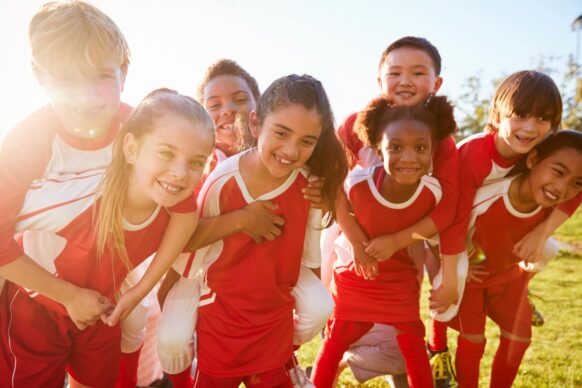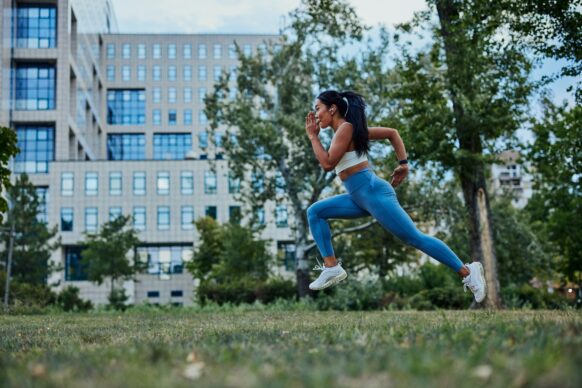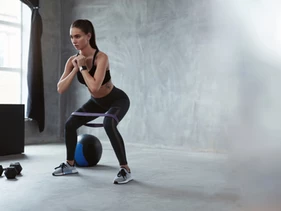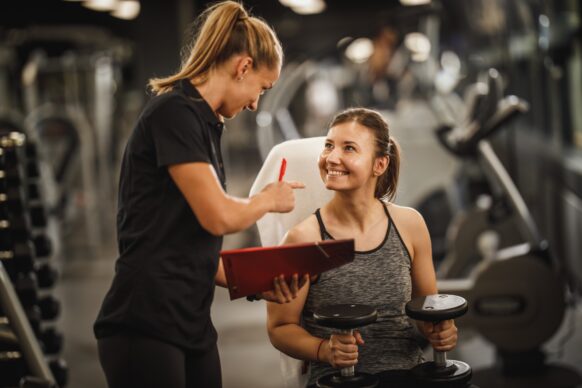by Samantha Herrera, DPT and Kelsea Brajkovich Schroeder, DPT
Children and adolescents were some of the first to be affected by changes made in our communities due to COVID-19 with the closure of schools and transition to completing school tasks at home. Many middle school and high school students may have only completed a few practices and maybe one competition in their organized sports before going through this transition. Our goal is to keep these kids active, moving, and strong so as to prepare them for their return to these organized sports activities by providing functional strength training exercises that should be incorporated in any cross training program no matter their sport. It has been shown that gains children have made in strength, hypertrophy, and power prior to their participation in spring sports or summer club teams can be lost in about 6 weeks once their strength training activities have stopped. As we round our 9th week of the Safer at Home order, there is no better time than now to provide adequate movement, strength, and cardiovascular training to lower their risk of injury and improve their skill for future participation in organized sports.
Balance and postural control skills mature to adult levels around 7 or 8 years of age. At this age children also demonstrate the necessary cognitive skills to benefit from instruction in proper form to when participating in a strength training routine. Your child may learn best through either watching you perform the exercise, hearing you verbally give them directions, or by receiving an occasional tap on their knee or hip to help with positioning and form throughout their routine. Overall, and especially with younger children (7-8 years), they learn well when led by example, so don’t be afraid to hop in with them during their routine; making it fun, providing lots of laughs and maybe incorporating these movements into a game so as to improve your child’s will and want to continue to participate in these movements with you. We want to create lifelong movers at this age, and when things get too serious, children begin to burnout and shy away from movement and participation in general. The transition to more serious and focused routines can begin around 12-13 years of age, when a child further understands the importance of strength and skill acquisition in practice of sport-specific exercises as it relates to their performance on their team and in competition.
The incorporation of the exercises provided below should focus on neuromuscular learning, meaning the focus is on gaining control in these movements, using only their body to provide the resistance. As skills develop in their movement pattern, addition of free weight resistance is indicated to progress strength training. For gains in strength to occur, it is shown that a program of 20-30 minutes in length performed 2-3 times per week with a 5 minute warm-up and cool-down (check out our first blog post in this series!) is ideal. Performance of strength training greater than 4 times per week in combination with sports may contribute to potential overuse injuries.
We have provided video instructions on performance of several movement patterns and functional strengthening exercises to be incorporated in any child’s plan, beginning at about 8 years of age. The exercises below address skilled movements necessary to progress to lower body, core, and upper body strengthening. The plyometric exercises add weave bone building and coordination benefits into their overall routine.
Squat
Introduce this movement by squatting with two feet on the ground. Once this movement can be controlled, progress to squatting on only one leg.
Equipment:
- Use a box to facilitate sitting backwards toward the box with your hips
Form Tips:
- Be sure your knees are not falling inward during this movement.
- Keep your hip, knee, and ankle all in line when completing the single leg squat.
Nordic Hamstring Curl *Best performed with a workout buddy to hold your feet and lower legs in place*
Start in a kneeling position, keeping your hips in line with your back and legs. Slowly lower your body forward toward the ground, squeezing your buttocks and core.
Equipment:
- Workout buddy to hold your legs for you, couch or ball to modify exercise and improve quality of movement
Form Tips:
- Lower as far as you can before you begin to bend at the hips. Loss of form indicates you are only able to control the movement up until this point, so rise back to upright position.
- This is where the use of a ball or edge of a couch is beneficial to modify your movement.
Lunge
Start in a standing position. Take a large step forward, keep feet hip width apart. Lower your body straight down toward the ground to lightly tap the knee on the ground. Rise straight up, then step forward to bring feet together. Repeat by alternating your leading leg.
Equipment:
- Body weight. Progress to 5 pound dumbbell once form and strength allow.
Form Tips:
- Make sure you step far enough (but not too far!) in order to have a 90 degree bend at your front knee and hip and back knee.
- Keep your forward hip, knee and ankle in line with each other.
- Lower as far as you can with control. If you lose your balance or this feels too difficult, make it a ‘mini’ lunge by only lowering halfway.
Plank to Downward Dog
Begin in a full plank position on your toes with legs hip-width apart and your palms planted on the ground below your shoulders. Hold your plank for 5 seconds, then raise your hips upwards, pushing back with your arms and shoulders while keeping your legs as straight as you can. Hold this position for 5 seconds and then repeat.
Equipment:
- Yoga mat or carpeted area
Form Tips:
- Keep your tummy tucked up toward your spine and hips in line with your body in plank position
- Maintain a straight back and your legs as straight as you can while pushing back and holding downward dog position.
Ladder Agility
This video provides some examples of agility and coordination drills to work into your strengthening routine that will help keep your heart rate up too! Pick 3 of the many in this video to work into your routine!
Equipment:
- Agility ladder. Don’t have a ladder like this at home? Try using masking tape or painter’s tape, or even chalk, to create lines on the sidewalk!
Form Tips:
- Start slow, then increase speed once the stepping becomes coordinated.
- Quick feet! Stay on the balls of your feet for quickness when landing then lowering into a squat, then shift weight back onto your heels.
- Quiet feet! Landing softly should be a goal when landing those hops and jumps.
Plyometrics
These sequenced jumps will help to improve muscle power, bone health and coordination. They are particularly beneficial for kids who are beginning organized and competitive sports requiring fast and skilled movements on the field or court.
Equipment:
- Step stool, curb, or bottom step of stairs to jump down and land from
Form Tips:
- Maintain knees outward when landing on two legs in a squat.
- Add the extra hop at the end once able to control the initial movement without losing balance.
- Try to add the extra jump in as fast as you can after landing. This is what really starts to work on power gains!
- Soft landings! Using cues like “landing quiet like a mouse” may help improve control with landing these jumps and hops.
Wondering about further specifics regarding form, frequency and intensity of your child’s workouts? Want a program that is tailored to your child’s needs and sports participation? Contact Evolution to schedule an in-person or telehealth session with us today! And email us with any additional questions about physical activity and strengthening for your kids!
samantha@evolution-pt.com (Brentwood Location)
kelsea@evolution-pt.com (Playa Vista/South Bay Location)




